
Chevalier: An Unsung Artist
Jess Hall, ASC, BSC helps illuminate a unique figure in French history.
The remarkable story of Joseph Bologne, Chevalier de Saint-Georges, resonated deeply with Jess Hall, ASC, BSC. In taking on the feature Chevalier, the cinematographer would assist in depicting the journey of the 18th-century violin virtuoso and composer (played by Kelvin Harrison Jr.), who was born in the French colony of Guadeloupe to a wealthy plantation owner and a Senegalese slave and later rose to the heights of French society despite his nonmarital birth and mixed race.
”When I got on the phone with [Chevalier director] Stephen Williams, who is also Jamaican, we realized we both understood this piece from the inside out and could collaborate very well.”
— Jess Hall, ASC, BSC
“The script was something very special and felt very personal to me — my own heritage is mixed Jamaican and English,” Hall says. “My father was born in Jamaica and moved to England; he was a Rhodes Scholar in 1951 and one of very few Black students at Oxford University. When I got on the phone with [Chevalier director] Stephen Williams, who is also Jamaican, we realized we both understood this piece from the inside out and could collaborate very well.”
As he began assembling materials that would inform his visual strategy, Hall notes, the film - makers’ references “included some images from films like The Age of Innocence [AC Oct. ’93], Dangerous Liaisons [AC May ’89] and, of course, Barry Lyndon [AC March ’76], which was a huge inspiration — but there were also works by master painters and still photographers, meaningful quotes and technical notes. All of that material provided a more complete picture of the overall plan.”
Harmonic Convergence
One of Williams’ goals was “a very subjective point of view,” Hall continues. “Stephen didn’t want to just stand back and watch a period tableau through formal-looking compositions. He wanted to feel the world of the Chevalier and how he experienced it, and to see the world reacting to him as he passed through it. That approach meant a lot of moving camera.”

Hall turned to A-camera/Steadicam operator Geoffrey Haley, who was also uniquely suited to telling this particular story. “Geoff was a concert cellist as a child, so I knew he was the right choice for this,” says Hall. “It took me a while to find him, but it was worth the wait. We wanted the camera movement to be very specifically choreographed to the score, predominantly in harmony with the music. Geoff was very interested in this concept. Some sections of the score were pre-recorded so we could play back on set.
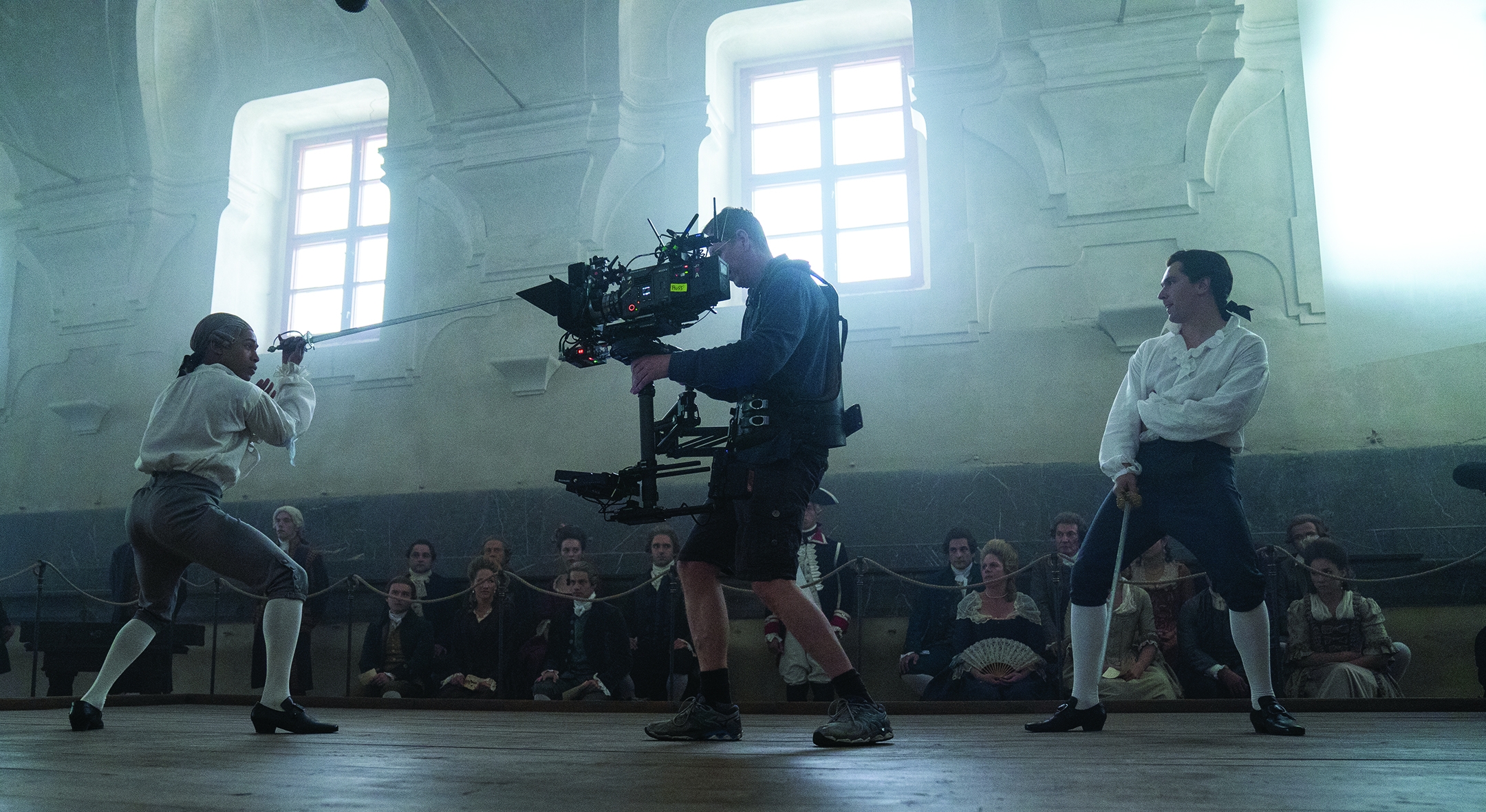
Hall continues, “If you’re using a telescopic crane, then you have one person on the arm, one person on the pickle and one person operating the remote head, and you have to coordinate with all three and try to get everyone in the same rhythm. But with Geoff operating Steadicam, it was one person handling all three axes of movement, and he could do it perfectly, feeling out every note of the score and responding in perfect sync. It was extremely rare that I felt he would make choices I wouldn’t. Aesthetically, we were really in tune with each other, and his Steadicam is so good that half the time it feels like a dolly.”
Low-Light Artistry
Chevalier marked Hall’s first use of the Sony Venice on a long-form project. “I had used it on commercials; I felt the color was a bit richer and I liked the look of the fast ISO compared to other camera options,” he explains. “I used the 2,500 ISO setting for all night interiors and exteriors, especially the candlelit sequences. For day interiors, I would usually drop to 500 ISO. I was very happy with the results.” For lenses, Hall worked with Panavision’s senior vice president of optical engineering, ASC associate member Dan Sasaki, to create a new lens series: Panavision Ultra High-Speed primes, which were made in 28mm, 35mm, 40mm, 50mm, 75mm and 100mm focal lengths, and ranged in speed from T0.9-T1.4.
When Hall began thinking about his lighting approach, “I couldn’t get Barry Lyndon out of my head, especially the candlelit scenes,” he says. “When I got the film and projected it, what struck me wasn’t the low light — even though that was groundbreaking — but that it didn’t feel like a dark and muddy film. Mrs. Lyndon just glows in those night interiors. I was dealing with a protagonist with a darker skin tone, and I wanted him to shine. Bologne was a composer, a champion swordsman, a lover and a French Revolutionary — he formed the only Black battalion to fight in the civil war — and the purpose of this film was to bring his story into the light.
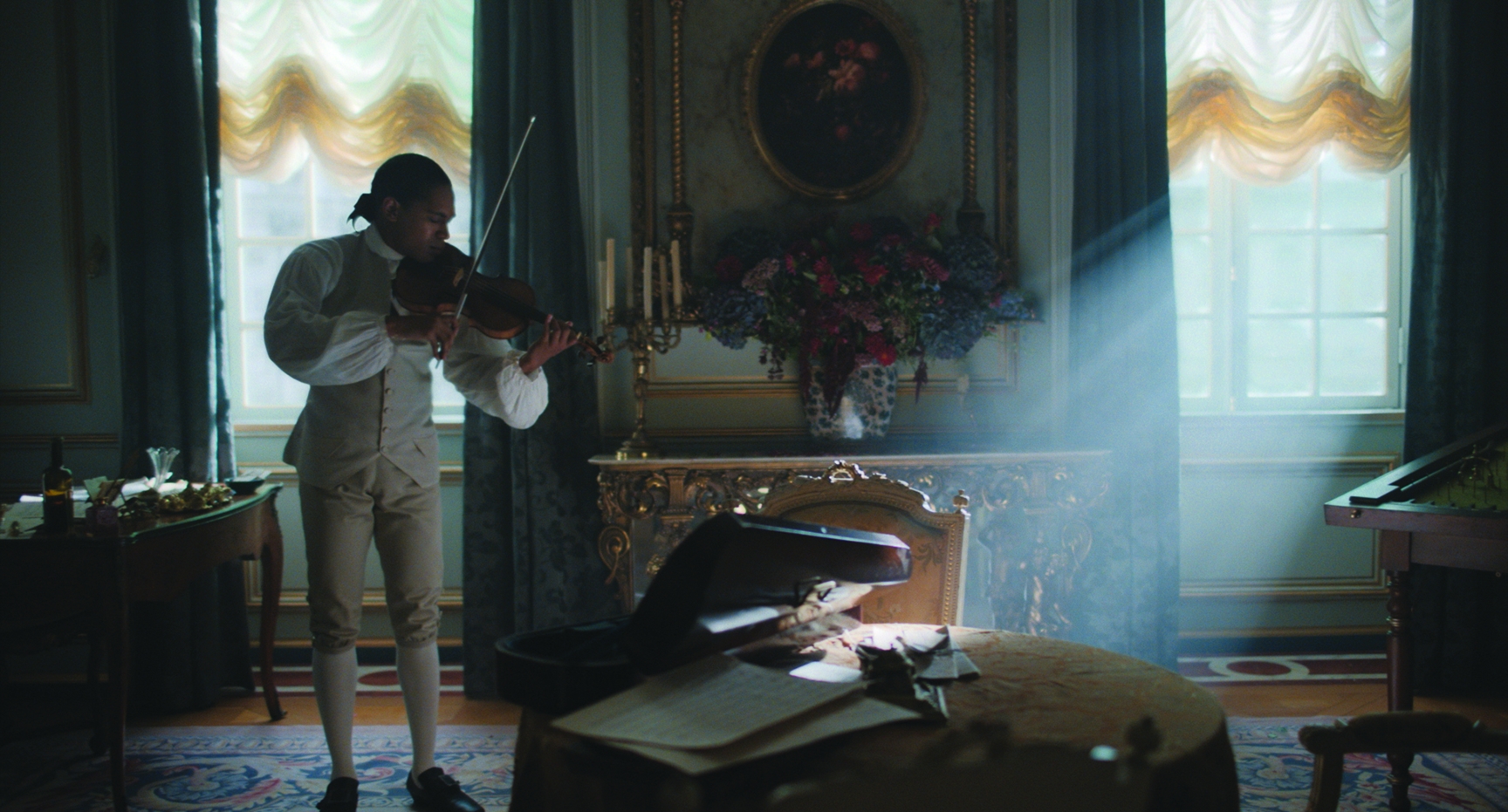

“As with most dark skin tones, I worked with more reflectivity on Kelvin’s face. I used a lot of silver reflector boards to key him, as well as traveling fixtures moving around with him — often a LightMat 2 with heavy diffusion and a smaller Creamsource [Micro Colour RGB] fixture.” The LightMat 2 was placed in a customized lightweight housing Hall designed so that the diffusion — in this case, Lee Heavy Frost 129 — could be mounted about 3" from the LED emitters, and the entire rig could be handheld without additional hardware.
The reflector boards used to key Harrison were often circular and covered with discontinued Rosco Soft Silver Spun material Hall has stored away. The cinematographer’s crew positioned bounces of multiple diameters around the actor to refine the bounce on his skin.
Impressionistic Images
Hall’s fine-art references included paintings by Thomas Gainsborough, Joshua Reynolds and Pierre-François Bouchard. “The thing about these paintings that I found really exciting was their impressionistic nature,” he says. “They’re not precise renderings. They don’t depict every pore and hair follicle on the subject’s head; they feature beautiful artistic renderings of faces. Chevalier is a true story, but we’re also taking artistic liberties, and I wanted this story to have an impressionistic feel.
“I didn’t want to over-compress the shadows,” he continues. “One of the things that I responded to in Barry Lyndon was the special light in these really dark scenes. With those images in mind, I started combining camera movement with natural sources and low light to give the photography an authentic feel.”
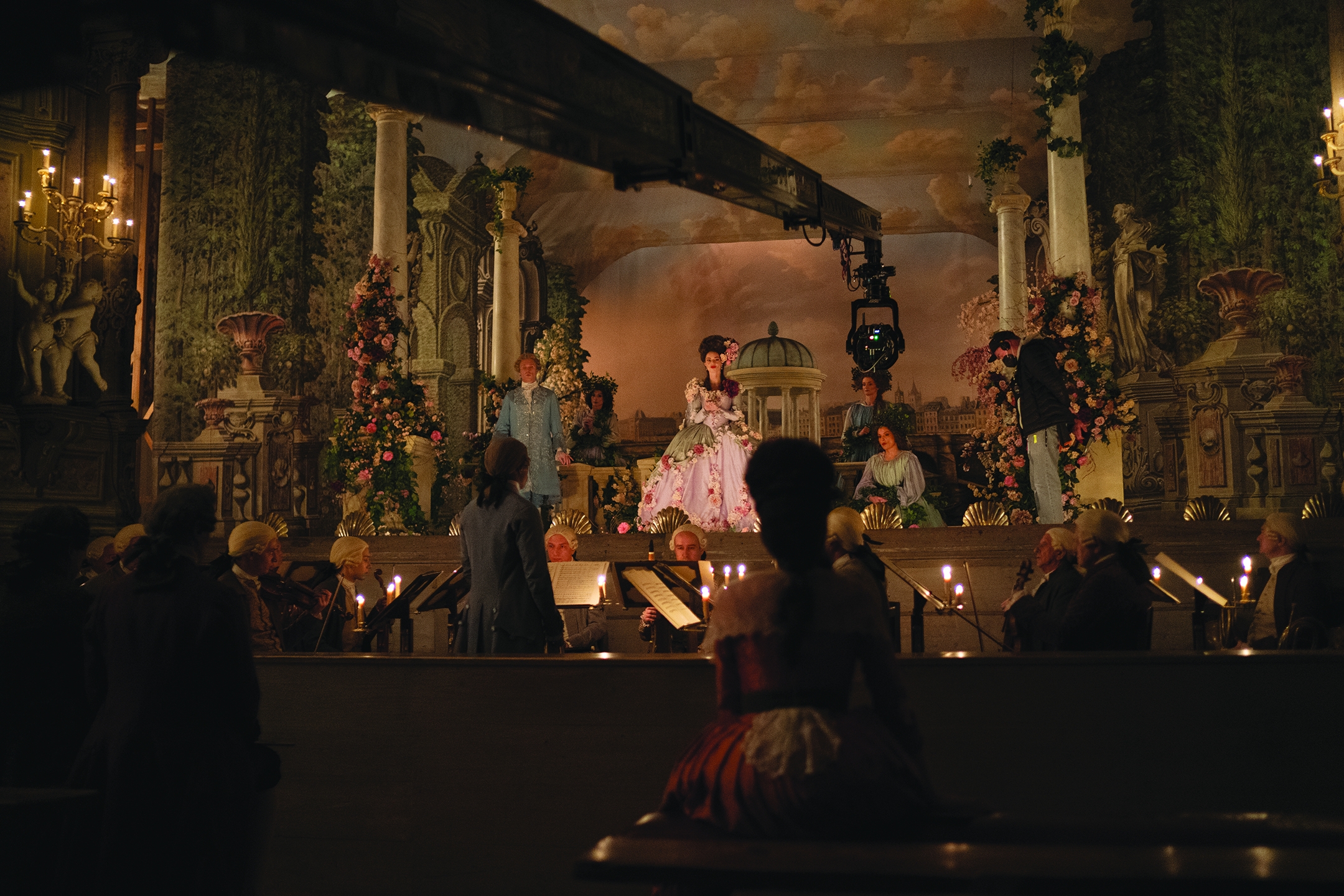
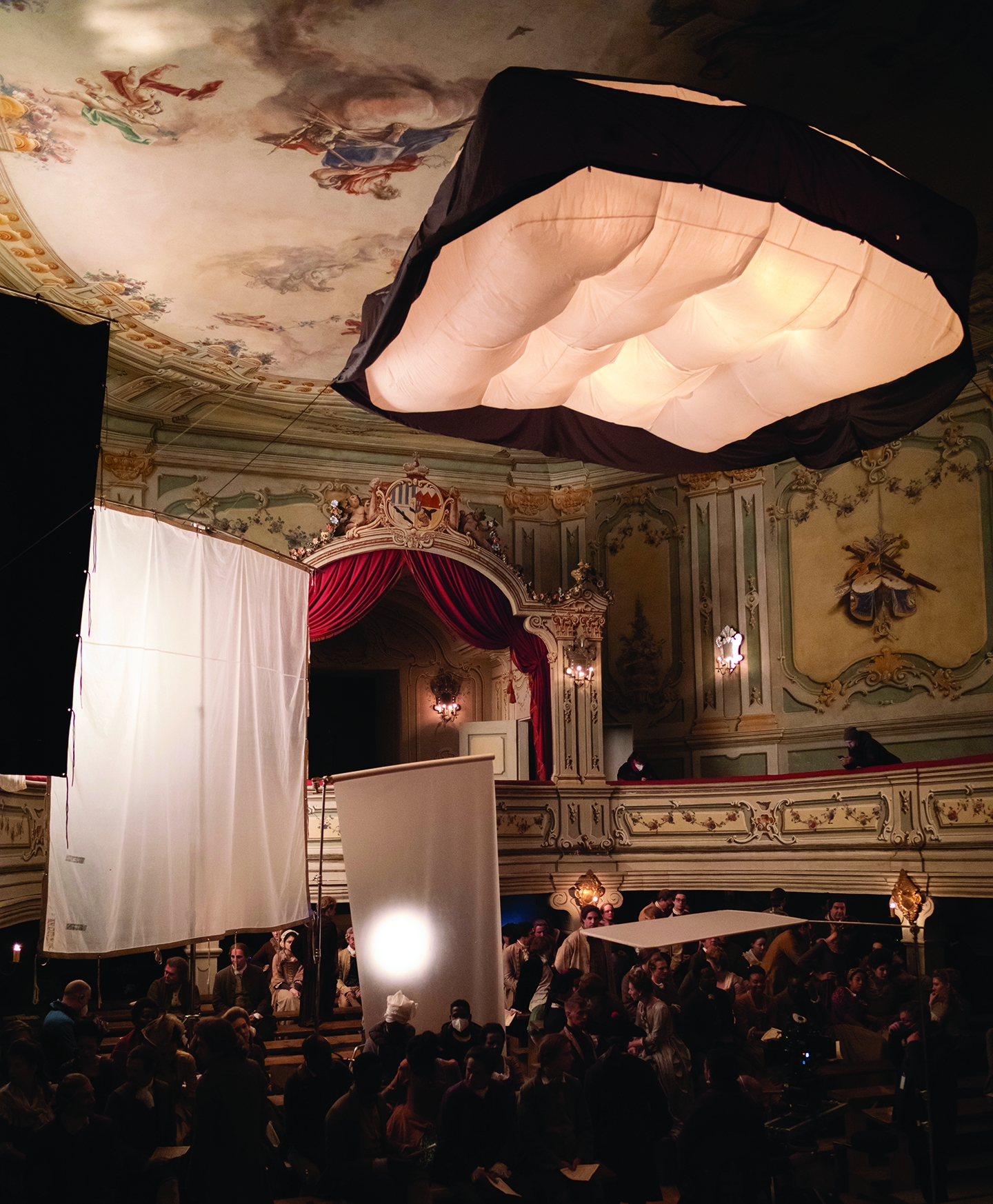
Working with practical candlelight, “I was able to shoot into candelabras and use the candles as key lights to get a beautiful rendering of Kelvin’s skin tone. I did use supplemental lighting, but this was set at extremely low levels.
“The candle is a relatively hard source, and using multiple candles can result in multiple shadows,” Hall adds. “In the testing phase, I saw this quickly and knew the placement of the candles relative to the actors’ blocking would be critical in reducing this risk.
“I used large tungsten sources as fill,” Hall adds. “Frequently, these were helium balloons that we retrofitted with multiple 1K tungsten bulbs. That gave us the flexibility to turn sections on and off and dim them to get a color temperature that matched the candles. We originally tried 650-watt PAR bulbs, but when we dimmed them to get the right color temp, we didn’t have enough output. I also used a lot of tungsten bounces and book lights as supplemental fill.”
Soft Northern Light
For day interiors, Hall wanted “that natural northern soft-light feel, where light is bouncing off buildings, not coming directly through windows. I grew up in northern Europe, and it often has this gray, reflective light. So, gaffer David Kriz and key grip David Vacek would set up large or small bounces of bleached muslins outside our set windows and bounce light into them to give us that soft, reflected light through the windows. It’s quintessentially French light. Add a little atmosphere, and that’s the look.”
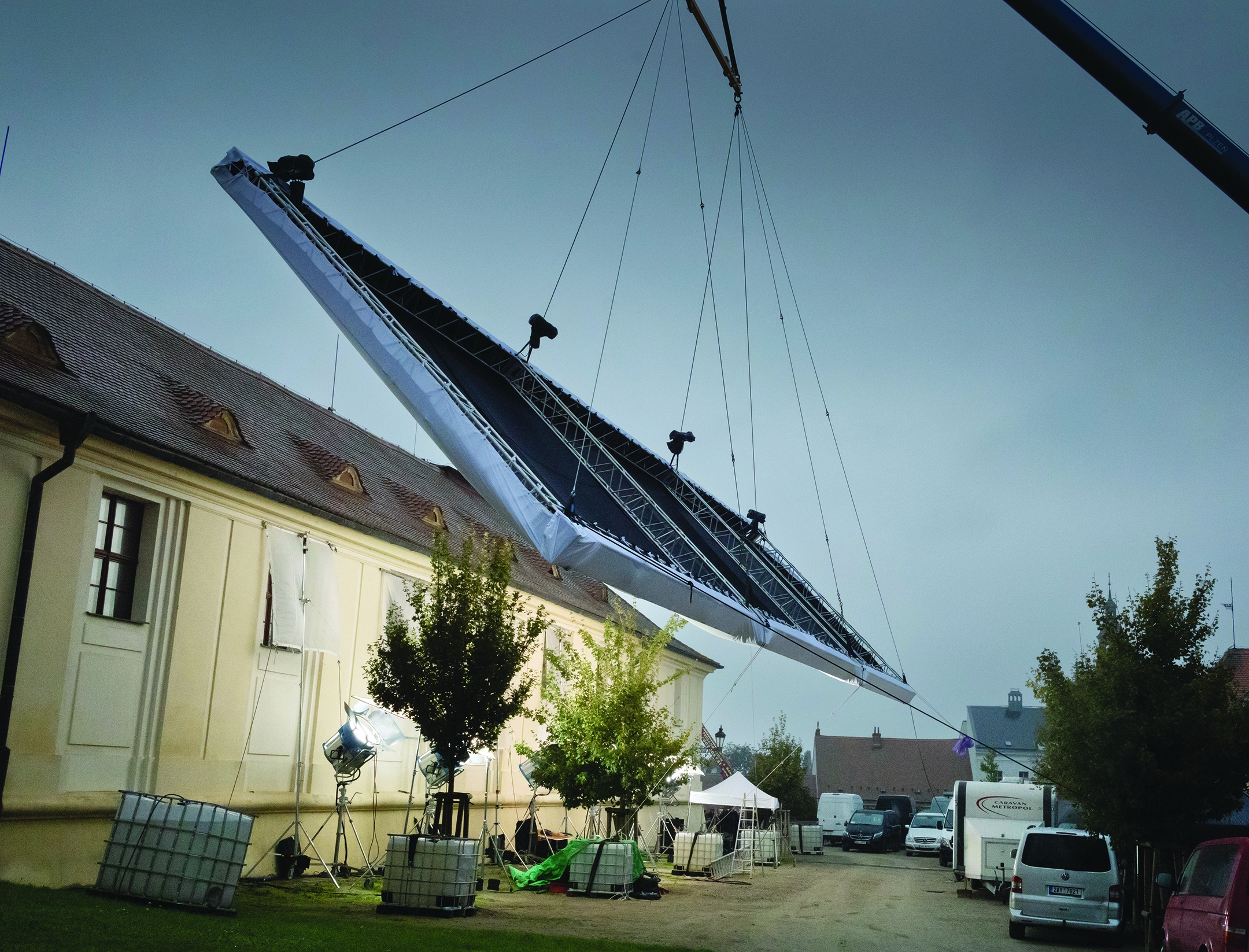
Elaborating on two variations of the team’s approach, Hall continues: “For the day interior scene where Bologne is victorious in a fencing match and made Chevalier, we used 100-foot bleached muslin outside the nine high windows, suspended from a construction crane at a 45-degree angle, with multiple Arri M90s and 18Ks bouncing into it. This also served as light control to maintain consistency, as the aspect allowed some sunlight to penetrate.
“We used a scaled-down version of this method for the studio work on the set for the Chevalier’s apartment,” he adds. “Here, the muslin bounces were smaller — mostly 12'x12' and 12'x20' — and the lights we used were Arri T12s.”
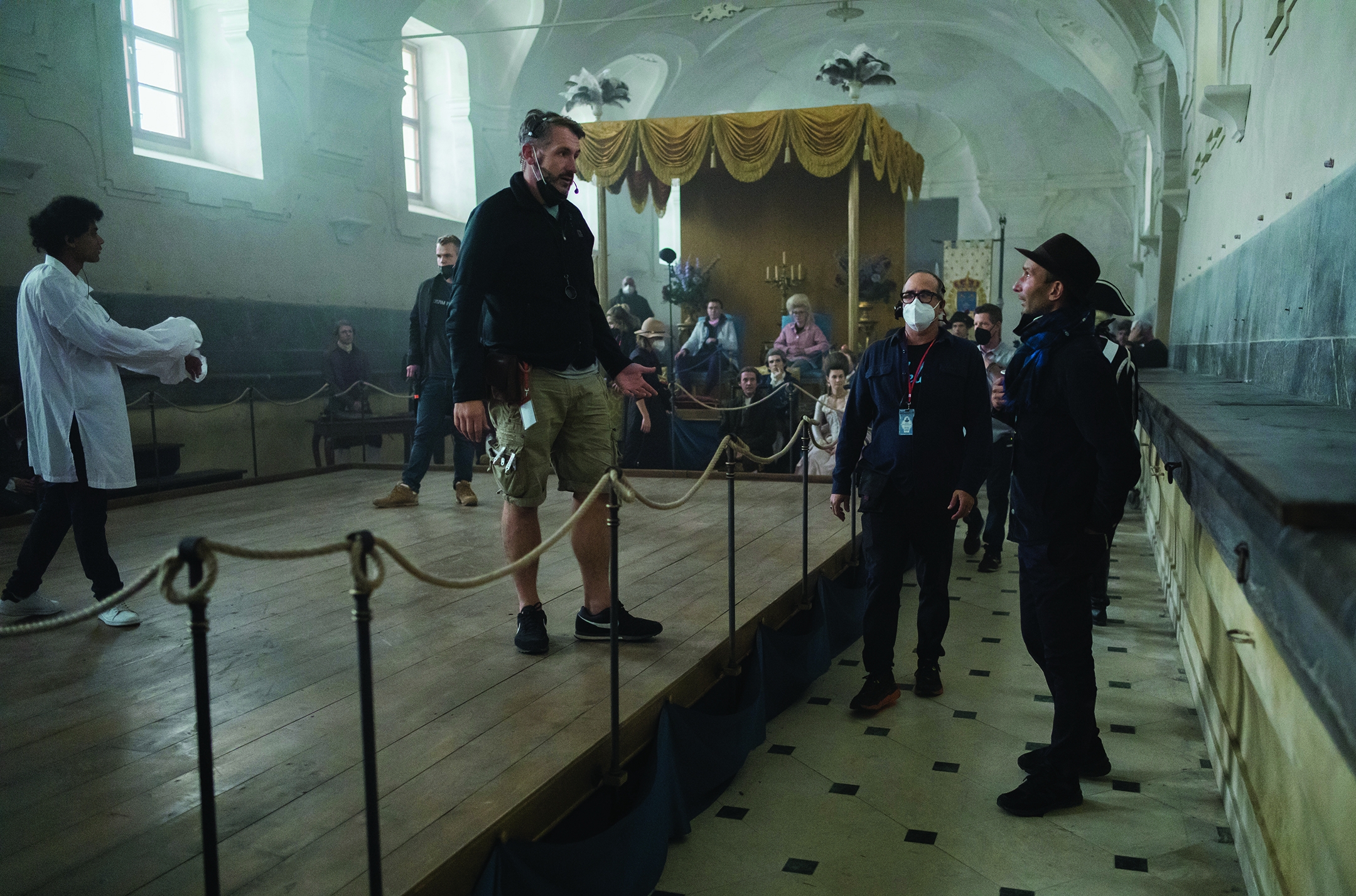
In Bologne’s apartment, Hall switched from a helium balloon to a soft box of Full Grid Cloth diffusion with a 40-degree egg-crate light control above the set, which was built onstage at Barrandov Studios in Prague. Inside the 20'x12' softbox were Arri S60 SkyPanels. Hall asked production designer Karen Murphy to leave a hole in the center of the ceiling, so this softbox could be recessed overhead. “That way, we could use the egg crate on the base of the softbox, as well as the physical ceiling of the set to cut the light off the walls and keep it as just a soft top fill light,” he notes.
Hall was working with such low light levels that 1st AC Craig Grossmueller, a longtime collaborator, was called upon to help — in ways that included having a Preston Cinema Light Ranger 2 specially tuned for the production. Grossmueller was the only regular crewmember Hall took with him to Prague. “I knew what we were doing was going to be incredibly challenging, focus-wise, so I really needed Craig,” Hall says. “He performed miracles.”
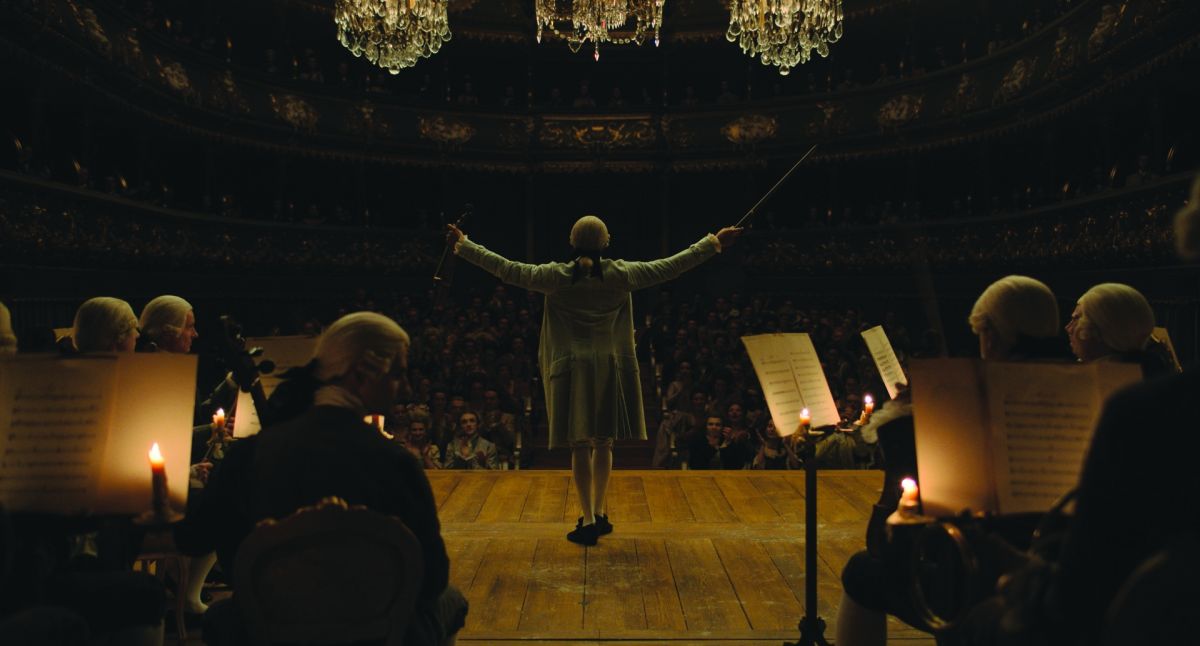
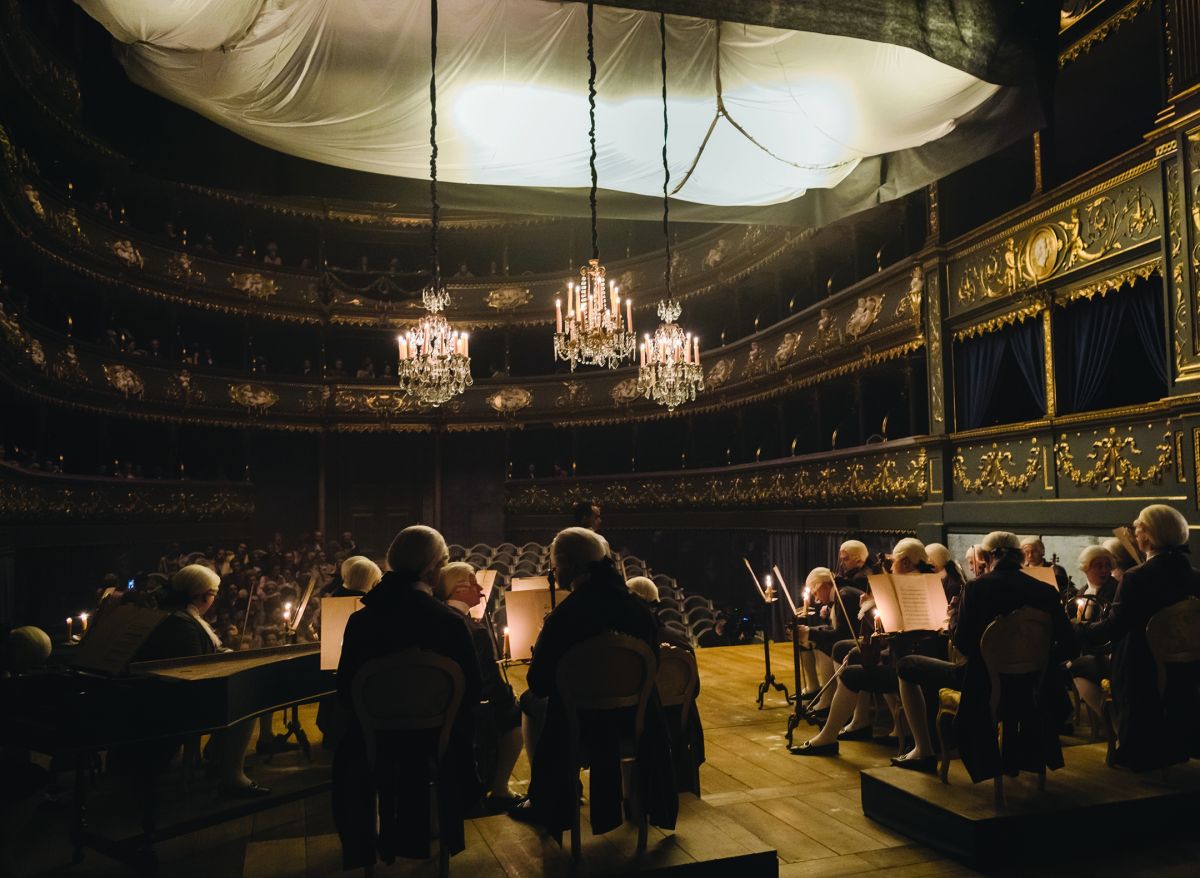
1.85:1
Cameras: Sony Venice
Lenses: Panavision Ultra High-Speed Prime, Panavision Macro
Jess Hall, ASC, BSC acknowledges he “had a pretty hefty list of requirements for Chevalier in terms of lenses” — and to meet them, Panavision’s Dan Sasaki devised an experimental set of T0.9-1.4 primes. Dubbed the “Ultra High-Speed Primes,” the lenses offer “a bit more of a vintage style, with softer contrast to give the feeling of deeper depth of field, even at incredibly fast stops,” Sasaki describes.
“One of the problems with larger-format and fast lenses is that depth of field becomes so shallow that it often becomes an image that is difficult to manage,” Sasaki notes. “But depth of field is a perception — it’s about what the eye sees and the brain determines is in focus relative to the information in a scene. If you have a super-sharp, contrasty lens, then it’s very easy to determine what is or isn’t in focus and the depth of field appears to be less. But, if you have a softer-contrast lens, where the slope of the MTF is more gradual and occupies a greater volume under the curve, the apparent difference of what is in focus and what is out of focus appears to be less abrupt, giving the impression of greater depth of field.”
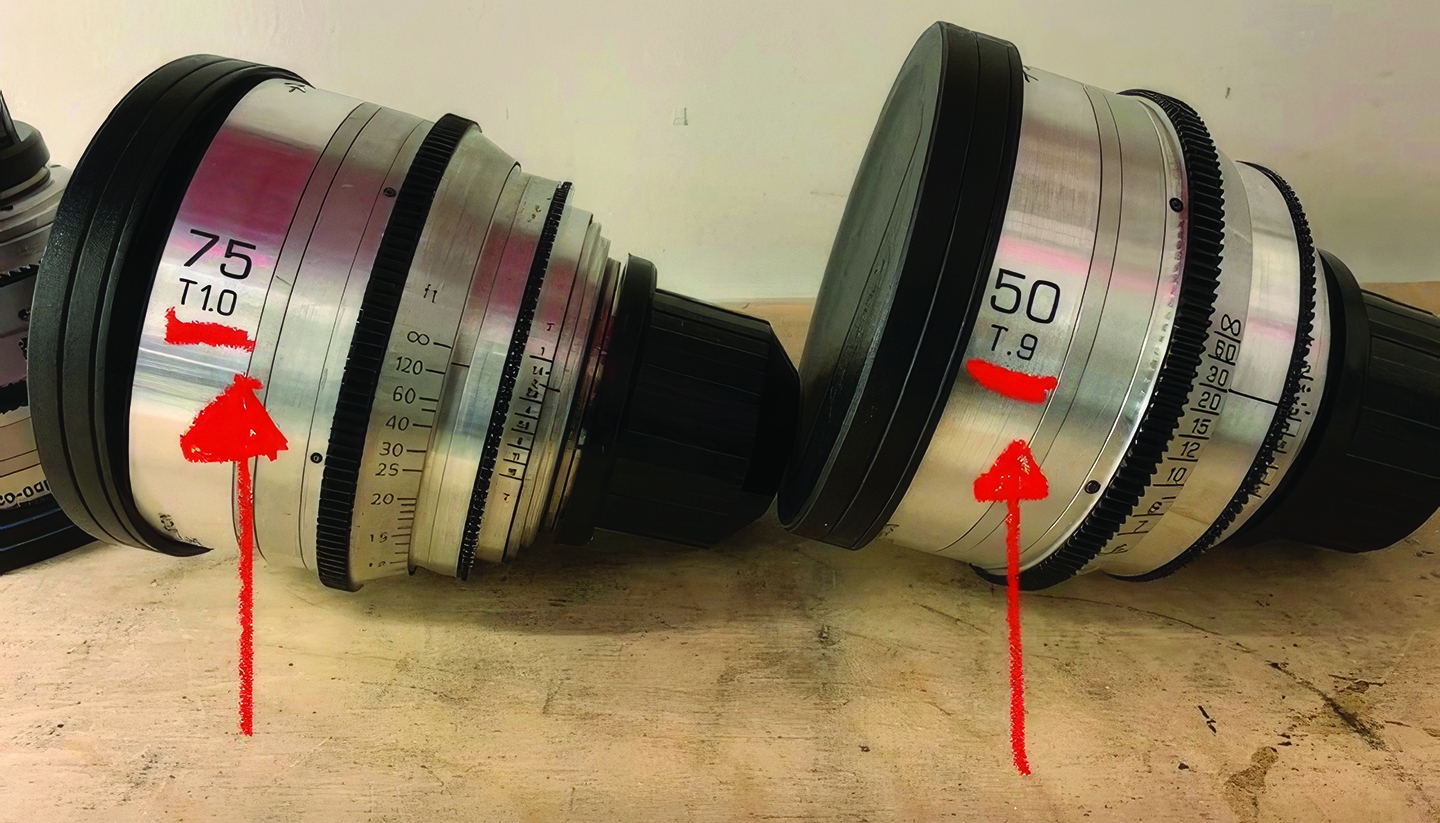
In the attempt to produce the illusion of greater depth with such a high-speed lens, Sasaki also manipulated the plane of focus (aka Petzval, or field curvature), making the edges of the image focus behind the central object — the opposite of most lenses — and the falloff more closely follow the curvature of the human face. (Editor’s note: The field of focus in a normal lens is a flat plane — parallel to the film plane. But in a “natural” or uncorrected lens, this field is curved forward so the center of the lens focuses farther away than the edges, and an optical designer has to force the edges to focus farther away so the plane is flat. In the case of Chevalier, Sasaki forced this plane to focus backward — away from the focus plane — so that the center would focus closer than the edges. This means that instead of just the tip of an actor’s nose being in sharp focus and everything else falling away, the plane of focus would form an ellipse that more closely followed a face. As a result, the area of faces that includes the nose and cheeks becomes more focused, making it appear that those images have more depth of field.)
“These lenses are never mathematically sharp,” Hall says, “but we were aiming for a more ethereal sharpness, where the falloff isn’t as extreme and you effectively get more perceived depth of field.”
The cinematographer also wanted the lenses to replicate the warm halation of the candlelit scenes in Barry Lyndon, and Sasaki’s efforts to achieve this led to a happy accident. “We really studied those images to look at the lenses’ aberrations,” Sasaki recalls. “While incorporating those aberrations into these new lenses, I actually made a big mistake. We had limited time to make the modifications, so we based the results on a lens projector. A couple of days before production, I got the look we’d discussed and was really excited to show Jess, and then I suddenly remembered that lens projection shows the opposite effect of aberrations! So, the warm halation I’d built into the lens actually became a blue/violet halation from photographed light. It was really lucky that Jess loved the effect. It added an additional, natural color separation to the highlights — but it was a mistake!”
Says Hall, “It was a mistake that parlayed into a unique look and became quite special. I fell in love with it.”

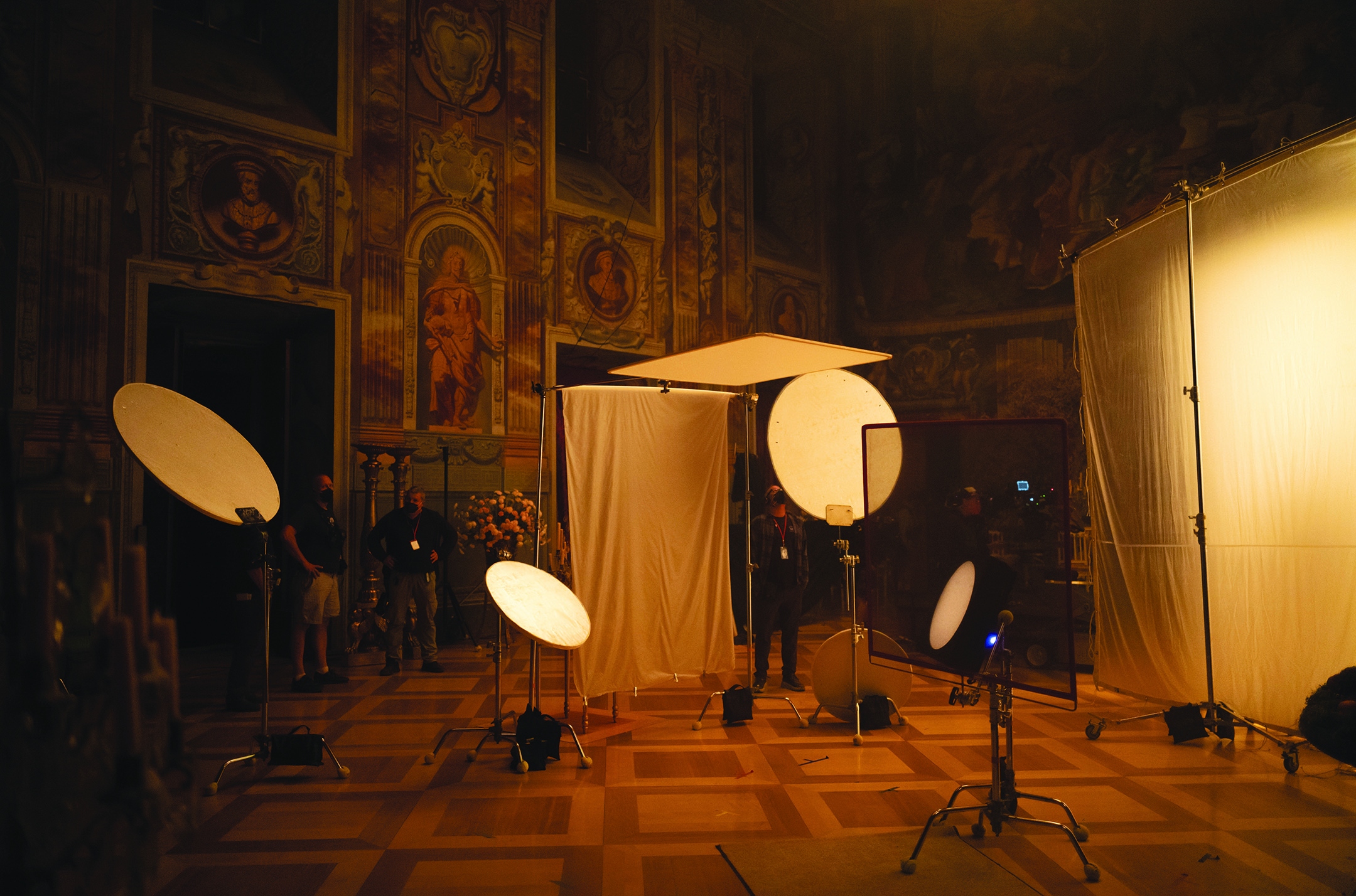
Sasaki describes the UHS primes as “an experimental set of lenses that were inspired by Barry Lyndon and Jess Hall’s love for vintage optics. They were also built to share some of the imaging characteristics of our new VA primes. Since the initial designs were capable of covering a 65mm sensor, we were able to reduce the diagonal and pick up some speed with a custom image circle reducer, which allowed us to produce lenses capable of an f/0.9 to f/1.4. This was a hugely experimental endeavor, and if it weren’t for Jess’ inspiration and patience, this project would not have taken off as well as it did.”
Hall notes, “The markings on our set — 0.9-1.4 — matched exactly what I found in testing and shooting, in relation to my light-meter readings — which were confirmed via waveform and precise monitoring. For example, when moving from the 50mm T0.9 to the 40mm T1.2, I had to raise the light levels by approximately half a stop. Changing focal length from the 50mm T0.9 to the 75mm T1 also required more light, and so on.
“Dan and I have this ongoing collaboration,” the cinematographer adds. “He brings something I can’t always bring, and we meet on very fertile ground.”
— Jay Holben






